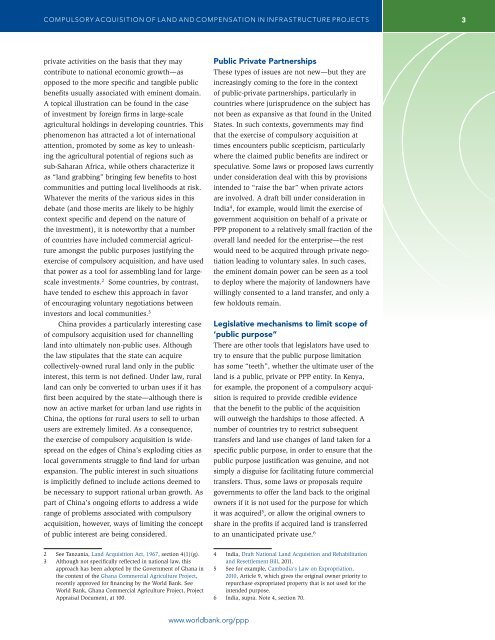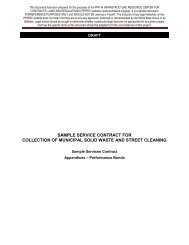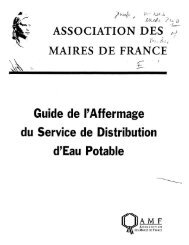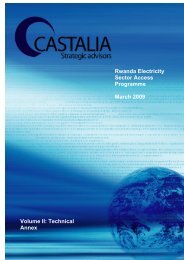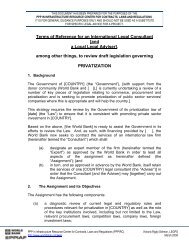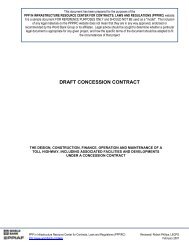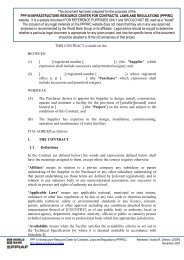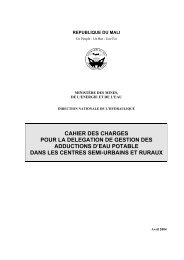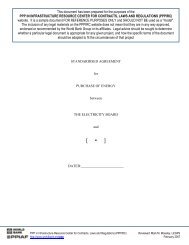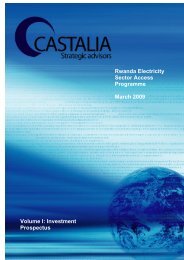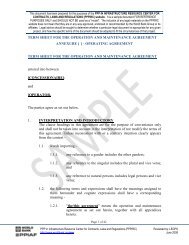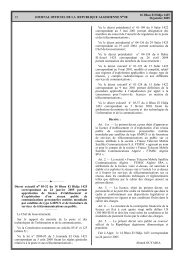Compulsory Acquisition of Land and Compensation in Infrastructure ...
Compulsory Acquisition of Land and Compensation in Infrastructure ...
Compulsory Acquisition of Land and Compensation in Infrastructure ...
Create successful ePaper yourself
Turn your PDF publications into a flip-book with our unique Google optimized e-Paper software.
<strong>Compulsory</strong> <strong>Acquisition</strong> <strong>of</strong> <strong>L<strong>and</strong></strong> <strong>and</strong> <strong>Compensation</strong> <strong>in</strong> <strong>Infrastructure</strong> Projects 3<br />
private activities on the basis that they may<br />
contribute to national economic growth—as<br />
opposed to the more specific <strong>and</strong> tangible public<br />
benefits usually associated with em<strong>in</strong>ent doma<strong>in</strong>.<br />
A topical illustration can be found <strong>in</strong> the case<br />
<strong>of</strong> <strong>in</strong>vestment by foreign firms <strong>in</strong> large-scale<br />
agricultural hold<strong>in</strong>gs <strong>in</strong> develop<strong>in</strong>g countries. This<br />
phenomenon has attracted a lot <strong>of</strong> <strong>in</strong>ternational<br />
attention, promoted by some as key to unleash<strong>in</strong>g<br />
the agricultural potential <strong>of</strong> regions such as<br />
sub-Saharan Africa, while others characterize it<br />
as “l<strong>and</strong> grabb<strong>in</strong>g” br<strong>in</strong>g<strong>in</strong>g few benefits to host<br />
communities <strong>and</strong> putt<strong>in</strong>g local livelihoods at risk.<br />
Whatever the merits <strong>of</strong> the various sides <strong>in</strong> this<br />
debate (<strong>and</strong> those merits are likely to be highly<br />
context specific <strong>and</strong> depend on the nature <strong>of</strong><br />
the <strong>in</strong>vestment), it is noteworthy that a number<br />
<strong>of</strong> countries have <strong>in</strong>cluded commercial agriculture<br />
amongst the public purposes justify<strong>in</strong>g the<br />
exercise <strong>of</strong> compulsory acquisition, <strong>and</strong> have used<br />
that power as a tool for assembl<strong>in</strong>g l<strong>and</strong> for largescale<br />
<strong>in</strong>vestments. 2 Some countries, by contrast,<br />
have tended to eschew this approach <strong>in</strong> favor<br />
<strong>of</strong> encourag<strong>in</strong>g voluntary negotiations between<br />
<strong>in</strong>vestors <strong>and</strong> local communities. 3<br />
Ch<strong>in</strong>a provides a particularly <strong>in</strong>terest<strong>in</strong>g case<br />
<strong>of</strong> compulsory acquisition used for channell<strong>in</strong>g<br />
l<strong>and</strong> <strong>in</strong>to ultimately non-public uses. Although<br />
the law stipulates that the state can acquire<br />
collectively-owned rural l<strong>and</strong> only <strong>in</strong> the public<br />
<strong>in</strong>terest, this term is not def<strong>in</strong>ed. Under law, rural<br />
l<strong>and</strong> can only be converted to urban uses if it has<br />
first been acquired by the state—although there is<br />
now an active market for urban l<strong>and</strong> use rights <strong>in</strong><br />
Ch<strong>in</strong>a, the options for rural users to sell to urban<br />
users are extremely limited. As a consequence,<br />
the exercise <strong>of</strong> compulsory acquisition is widespread<br />
on the edges <strong>of</strong> Ch<strong>in</strong>a’s explod<strong>in</strong>g cities as<br />
local governments struggle to f<strong>in</strong>d l<strong>and</strong> for urban<br />
expansion. The public <strong>in</strong>terest <strong>in</strong> such situations<br />
is implicitly def<strong>in</strong>ed to <strong>in</strong>clude actions deemed to<br />
be necessary to support rational urban growth. As<br />
part <strong>of</strong> Ch<strong>in</strong>a’s ongo<strong>in</strong>g efforts to address a wide<br />
range <strong>of</strong> problems associated with compulsory<br />
acquisition, however, ways <strong>of</strong> limit<strong>in</strong>g the concept<br />
<strong>of</strong> public <strong>in</strong>terest are be<strong>in</strong>g considered.<br />
Public Private Partnerships<br />
These types <strong>of</strong> issues are not new—but they are<br />
<strong>in</strong>creas<strong>in</strong>gly com<strong>in</strong>g to the fore <strong>in</strong> the context<br />
<strong>of</strong> public-private partnerships, particularly <strong>in</strong><br />
countries where jurisprudence on the subject has<br />
not been as expansive as that found <strong>in</strong> the United<br />
States. In such contexts, governments may f<strong>in</strong>d<br />
that the exercise <strong>of</strong> compulsory acquisition at<br />
times encounters public scepticism, particularly<br />
where the claimed public benefits are <strong>in</strong>direct or<br />
speculative. Some laws or proposed laws currently<br />
under consideration deal with this by provisions<br />
<strong>in</strong>tended to “raise the bar” when private actors<br />
are <strong>in</strong>volved. A draft bill under consideration <strong>in</strong><br />
India 4 , for example, would limit the exercise <strong>of</strong><br />
government acquisition on behalf <strong>of</strong> a private or<br />
PPP proponent to a relatively small fraction <strong>of</strong> the<br />
overall l<strong>and</strong> needed for the enterprise—the rest<br />
would need to be acquired through private negotiation<br />
lead<strong>in</strong>g to voluntary sales. In such cases,<br />
the em<strong>in</strong>ent doma<strong>in</strong> power can be seen as a tool<br />
to deploy where the majority <strong>of</strong> l<strong>and</strong>owners have<br />
will<strong>in</strong>gly consented to a l<strong>and</strong> transfer, <strong>and</strong> only a<br />
few holdouts rema<strong>in</strong>.<br />
Legislative mechanisms to limit scope <strong>of</strong><br />
‘public purpose”<br />
There are other tools that legislators have used to<br />
try to ensure that the public purpose limitation<br />
has some “teeth”, whether the ultimate user <strong>of</strong> the<br />
l<strong>and</strong> is a public, private or PPP entity. In Kenya,<br />
for example, the proponent <strong>of</strong> a compulsory acquisition<br />
is required to provide credible evidence<br />
that the benefit to the public <strong>of</strong> the acquisition<br />
will outweigh the hardships to those affected. A<br />
number <strong>of</strong> countries try to restrict subsequent<br />
transfers <strong>and</strong> l<strong>and</strong> use changes <strong>of</strong> l<strong>and</strong> taken for a<br />
specific public purpose, <strong>in</strong> order to ensure that the<br />
public purpose justification was genu<strong>in</strong>e, <strong>and</strong> not<br />
simply a disguise for facilitat<strong>in</strong>g future commercial<br />
transfers. Thus, some laws or proposals require<br />
governments to <strong>of</strong>fer the l<strong>and</strong> back to the orig<strong>in</strong>al<br />
owners if it is not used for the purpose for which<br />
it was acquired 5 , or allow the orig<strong>in</strong>al owners to<br />
share <strong>in</strong> the pr<strong>of</strong>its if acquired l<strong>and</strong> is transferred<br />
to an unanticipated private use. 6<br />
2 See Tanzania, <strong>L<strong>and</strong></strong> <strong>Acquisition</strong> Act, 1967, section 4(1)(g).<br />
3 Although not specifically reflected <strong>in</strong> national law, this<br />
approach has been adopted by the Government <strong>of</strong> Ghana <strong>in</strong><br />
the context <strong>of</strong> the Ghana Commercial Agriculture Project,<br />
recently approved for f<strong>in</strong>anc<strong>in</strong>g by the World Bank. See<br />
World Bank, Ghana Commercial Agriculture Project, Project<br />
Appraisal Document, at 100.<br />
4 India, Draft National <strong>L<strong>and</strong></strong> <strong>Acquisition</strong> <strong>and</strong> Rehabilitation<br />
<strong>and</strong> Resettlement Bill, 2011.<br />
5 See for example, Cambodia’s Law on Expropriation,<br />
2010, Article 9, which gives the orig<strong>in</strong>al owner priority to<br />
repurchase expropriated property that is not used for the<br />
<strong>in</strong>tended purpose.<br />
6 India, supra. Note 4, section 70.<br />
www.worldbank.org/ppp


